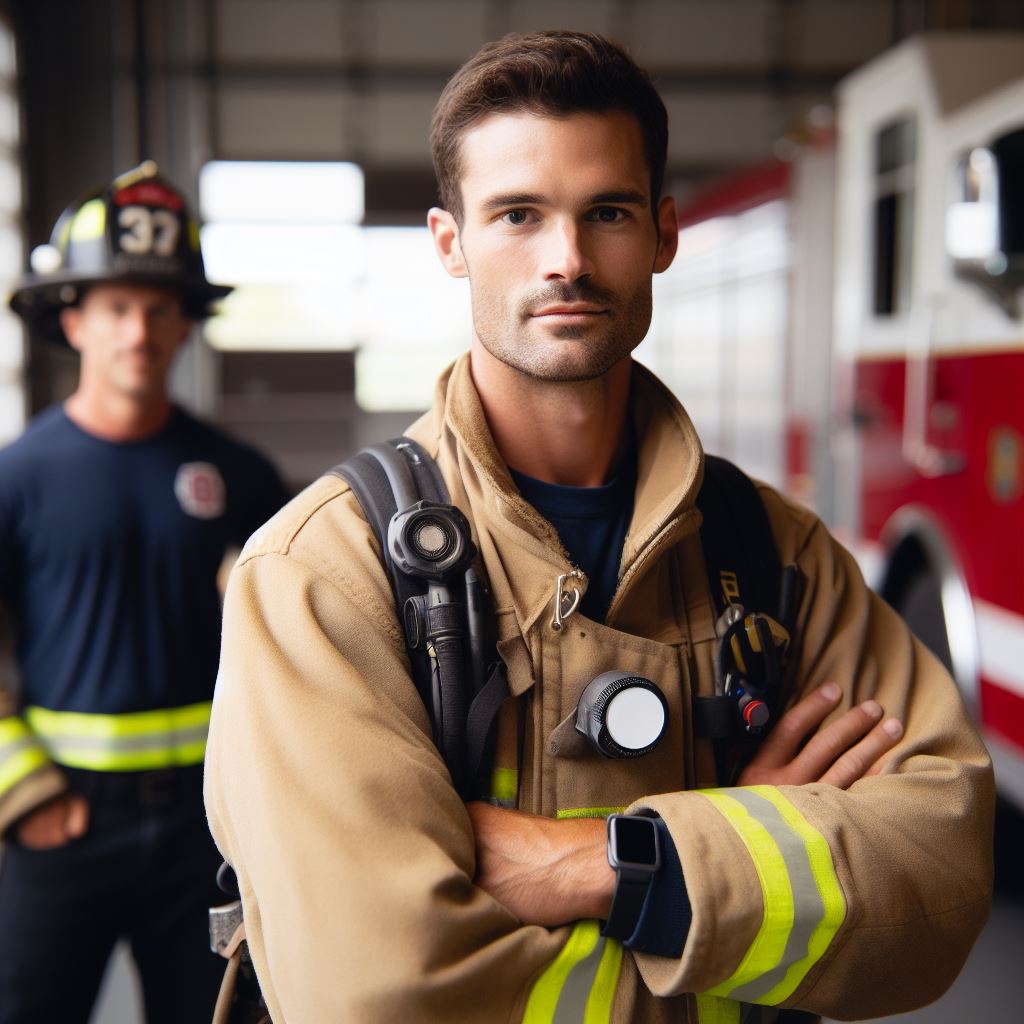Fire Department Hierarchies: From Rookie to Chief
Last Updated on January 27, 2024
Introduction
Fire Department Hierarchies: Understanding the Structure and Importance
Fire department hierarchies play a crucial role in ensuring efficient operations and effective emergency response.
Knowing and comprehending the hierarchy within fire departments is essential for both firefighters and the general public.
The importance of understanding the hierarchy within fire departments cannot be overstated.
It establishes a clear chain of command, promotes accountability, and facilitates effective decision-making during emergency situations.
Additionally, understanding the hierarchy ensures a smooth workflow and coordination among firefighters and other personnel.
In this blog section, we will delve deeper into the topic of fire department hierarchies.
We will explore the various ranks and positions within fire departments and discuss the roles and responsibilities associated with each level.
By understanding the structure and dynamics of fire department hierarchies, we can gain insight into the inner workings and functionality of these essential public safety organizations.
Throughout the section, we will highlight the significance of a clear hierarchy and how it contributes to the overall effectiveness and success of fire departments.
This understanding can help firefighters navigate the chain of command, improve communication, and enhance their ability to respond to emergencies swiftly and efficiently.
Moreover, we will address the role of leadership within fire department hierarchies, as well as the challenges and opportunities that arise at each level.
By examining the progression from rookie to chief, we will shed light on the personal and professional development required to advance within the fire department hierarchy.
Join us as we unravel the intricacies of fire department hierarchies and gain a deeper understanding of the vital role they play in safeguarding our communities.
Read: Military Benefits: From Healthcare to Education Aid
The Rookie Phase
In the fire department, the rookie phase marks the beginning of a firefighter’s career. This stage is crucial, as new recruits transition from training to practical experience in the field.
Definition of a Rookie Firefighter
- A rookie firefighter is a newly hired or trained individual who has completed the necessary qualifications to become an active firefighter.
- During this phase, rookies are considered the lowest-ranking members of the fire department hierarchy.
Training and Probationary Period
- Rookies undergo extensive training programs to acquire the essential knowledge and skills needed for their role.
- This training includes both classroom instruction and hands-on practice in firefighting techniques and emergency response.
- The probationary period, which typically lasts around six months to a year, follows the initial training phase.
- During probation, rookies are closely supervised and evaluated to ensure their competence and readiness for active duty.
Roles and Responsibilities of a Rookie Firefighter
- Rookies are primarily responsible for supporting and assisting more experienced firefighters during emergency situations.
- They actively participate in firefighting operations, following the guidance of their superiors.
- Rookies also perform various tasks such as setting up equipment, handling hoses, and providing general assistance.
- Moreover, they help maintain the readiness of the fire station by conducting routine inspections and cleaning.
- Building familiarity with local streets, fire hydrants, and geographical layout is another crucial responsibility of rookies.
- Rookies are expected to perform their duties with dedication, professionalism, and a commitment to teamwork.
- They must demonstrate the ability to follow orders promptly and efficiently while adapting to different situations.
The rookie phase serves as the foundation of a firefighter’s career. It allows individuals to apply their theoretical knowledge to real-life scenarios and further develop their skills.
During this phase, rookies gain the practical experience necessary to progress within the fire department hierarchy and eventually climb the ranks.
Throughout their training and probationary period, rookies are constantly learning, adapting, and proving themselves through their actions.
This phase also provides an opportunity for rookies to better understand their strengths and weaknesses, enabling them to grow both personally and professionally.
In general, the rookie phase is an essential part of a firefighter’s journey.
It shapes their understanding of the fire department’s operations, hones their skills, and instills vital values such as discipline, teamwork, and responsibility.
By embracing their roles and responsibilities as rookies, firefighters lay the groundwork for a successful and fulfilling career in the fire service.
Read: Top U.S. Military Bases: Key Locations & Their Importance
Advancing through the Ranks
In the fire department hierarchy, firefighters have various opportunities for advancement and growth in their careers.
Moving up from being a rookie firefighter to eventually becoming a chief requires dedication, experience, and the acquisition of specific skills at each stage of their journey.
Firefighter to Engineer or Apparatus Operator
- As an Engineer, duties include operating and maintaining fire engines and other specialized vehicles.
- To become an Engineer, one must possess technical skills in vehicle maintenance and operation.
A firefighter who aspires to advance can progress to the role of an engineer or apparatus operator.
As an engineer, their main duties revolve around operating and maintaining fire engines and other specialized vehicles used in firefighting.
They are responsible for ensuring the proper functioning and readiness of these vehicles.
To become an engineer, firefighters need to possess technical skills related to vehicle maintenance and operation, along with a good understanding of the equipment used.
Engineer to Lieutenant
- A Lieutenant’s responsibilities involve supervising and coordinating activities of firefighters in a company.
- Skills required for becoming a Lieutenant include decision-making, communication, and problem-solving abilities.
- In this role, leadership is crucial in guiding and motivating firefighters under their command.
Moving up from engineer to the rank of lieutenant comes with increased responsibilities and the opportunity to demonstrate leadership capabilities.
A lieutenant’s role involves supervising and coordinating the activities of firefighters within a company.
They are responsible for ensuring safety protocols are followed and for making critical decisions during emergencies.
Becoming a lieutenant requires a set of skills beyond technical expertise, including effective communication, decision-making, and problem-solving abilities.
In this role, leadership is paramount, as lieutenants guide and motivate the firefighters under their command, ensuring the smooth functioning of their team.
Lieutenant to Captain
- A Captain is responsible for managing a fire company and overseeing emergency operations.
- Becoming a Captain requires skills in strategic planning, resource allocation, and team coordination.
- Captains play a vital role in leading and managing a team, ensuring effective and efficient firefighting efforts.
The next step in the hierarchy is becoming a captain. Captains hold a managerial position and are responsible for managing a fire company and overseeing emergency operations.
They must possess skills in strategic planning, resource allocation, and team coordination to effectively carry out their responsibilities.
Captains often play a crucial role in leading and managing a team during emergencies, ensuring that all members are working together efficiently and effectively.
Their ability to provide clear instructions, delegate tasks, and make critical decisions contributes to the overall success of firefighting efforts.
Advancing through the ranks in the fire department requires not only acquiring the necessary skills but also demonstrating leadership qualities.
From the earliest stages as a firefighter to the top positions of chief officers, each rank demands a unique set of responsibilities and abilities.
By continuously striving to improve their skills and taking on leadership roles, firefighters can pave their way towards becoming effective and respected leaders within the fire department.
Read: Deployment Dynamics: Understanding Overseas Assignments

Uncover the Details: Diverse Voices: Ethnic Minorities in the U.S. Military
You Might Also Like: Mental & Physical Health Tips for Police Officers
Reaching the Executive Positions
Captain to Battalion Chief
Duties and responsibilities of a Battalion Chief
A Battalion Chief is responsible for supervising and coordinating activities at multiple fire stations or districts.
They provide guidance, support, and feedback to firefighters and other personnel, ensuring that operations run smoothly and efficiently.
Additionally, they are in charge of developing emergency response plans, conducting training sessions, and evaluating the performance of their subordinates.
Skills required to become a Battalion Chief
To excel in the role of a Battalion Chief, individuals must possess a diverse range of skills. Strong leadership abilities are crucial, as they need to inspire and motivate their teams.
Excellent communication and interpersonal skills are essential for establishing effective working relationships with colleagues and members of the community.
Analytical thinking and problem-solving skills are also vital for making critical decisions during emergency situations.
In addition, a deep knowledge of fire department procedures and regulations is necessary to ensure compliance and overall effectiveness.
Role in overseeing multiple fire stations or districts
As a Battalion Chief, one of the primary responsibilities is to oversee the operations of multiple fire stations or districts.
They act as a direct supervisor to Captains, Lieutenants, and firefighters at each station, providing guidance, enforcing policies, and ensuring that resources are efficiently allocated.
They are also responsible for coordinating emergency responses, collaborating with other departments, and conducting investigations into incidents or accidents.
By overseeing multiple stations, Battalion Chiefs play a critical role in maintaining the safety of their communities.
Battalion Chief to Assistant Chief
Duties and responsibilities of an Assistant Chief
An Assistant Chief is a high-ranking position within the fire department hierarchy. Their role is to manage department-wide operations and implement strategies to improve efficiency and effectiveness.
They collaborate with other Assistant Chiefs and the Fire Chief to develop and enforce department policies, ensuring that they are aligned with community needs and regulations.
They also oversee training programs, budgeting, and resource allocation, while maintaining strong relationships with external stakeholders.
Skills required to become an Assistant Chief
To step into the position of an Assistant Chief, individuals must possess exceptional leadership skills.
They need to motivate and inspire their subordinates, while effectively delegating tasks and managing overall performance.
Strategic thinking and the ability to analyze data for informed decision-making are crucial for driving continuous improvement within the department.
Furthermore, strong communication skills are necessary to interact with various internal and external stakeholders, including political figures, community leaders, and other emergency service agencies.
Role in managing operations and implementing department-wide strategies
Assistant Chiefs are responsible for overseeing and managing the day-to-day operations of the fire department.
They work closely with Battalion Chiefs, Captains, and Lieutenants to ensure that policies and procedures are followed, resources are allocated efficiently, and training programs are up to date.
Additionally, they play a crucial role in developing and implementing department-wide strategies, aiming to improve response times, enhance community engagement, and foster a culture of continuous improvement.
Assistant Chief to Chief
Duties and responsibilities of a Fire Chief
The Fire Chief is the highest-ranking position in the fire department hierarchy. Their primary duty is to lead the entire fire department, overseeing all operations, policies, and personnel.
Fire Chiefs are responsible for setting department goals and objectives, establishing long-term strategies, and making crucial decisions to ensure the safety of the community.
They ensure compliance with regulations, handle budgeting and resource allocation, and serve as the public face of the fire department.
Skills required to become a Fire Chief
Becoming a Fire Chief requires exceptional leadership skills, strategic thinking, and decision-making abilities.
Fire Chiefs must possess a deep understanding of fire department operations, emergency management, and community engagement.
They need to build and nurture strong relationships with stakeholders, including government officials, civic leaders, and other emergency service organizations.
Effective communication and negotiation skills are vital for successfully advocating for resources, policies, and the needs of the fire department and the community.
Role in leading the entire fire department and making crucial decisions
As the head of the fire department, the Fire Chief plays a critical role in leading and managing all aspects of the organization.
They set the vision and direction for the department, establish priorities, and make crucial decisions in response to emergencies or community needs.
Fire Chiefs create a positive work environment, foster professional development, and ensure efficient department operations, emphasizing inclusivity and effectiveness.
They are ultimately accountable for the overall performance and success of the fire department.
Read: The Training Rigor: Preparing for Combat & Peacekeeping
Conclusion
Fire department hierarchies covered
Throughout this blog section, we have explored the various hierarchies within a fire department.
We started with the entry-level position of a rookie firefighter, who undergoes rigorous training and gains experience over time.
From there, we discussed the roles of a firefighter, lieutenant, captain, battalion chief, and finally, the chief. Each position carries increasing responsibilities and requires specific skills and expertise.
The Importance of each role in the hierarchy
Each role in the fire department hierarchy plays a crucial part in ensuring the overall safety and effectiveness of the department’s operations.
From fighting fires to handling emergencies, each position contributes to the success of the team.
The rookie firefighter brings new energy and a willingness to learn, while the lieutenant provides guidance and leadership to their team.
Captains oversee multiple fire companies and make critical decisions during emergencies.
Battalion chiefs manage multiple fire stations and coordinate resources, while the chief of the department oversees the entire operation and sets strategic goals for the future.
Appreciation for the dedication and expertise of fire department personnel
It is important to acknowledge and appreciate the dedication and expertise of fire department personnel at every level of the hierarchy.
Their commitment to public safety is commendable, and they often put their lives at risk to protect and serve their communities.
The extensive training, experience, and ongoing professional development of these individuals ensure that they are well-prepared to face the challenges that come their way.
In the end, fire department hierarchies are structured to maximize efficiency and ensure the safety of both firefighters and the public.
Each role has its significance and contributes to the overall success of the department. We should always have gratitude for the brave men and women who serve in these essential positions.


